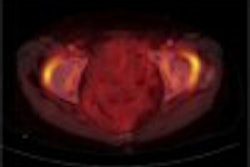CHICAGO - Quantitative CT perfusion imaging appears to give doctors a means to determine if the patient suffering an acute stroke is at risk of suffering hemorrhage with thrombolytic therapy.
By calculating cerebral blood flow and volume in various regions of the brain during acute stroke, it was possible to identify patients for whom thrombolytic therapy should or should not be recommended, said Dr. Pamela Schaefer, assistant professor of radiology at Harvard Medical School, Boston.
"These are preliminary results and include small numbers of patients," Schaefer said during an oral presentation at the 2003 RSNA meeting.
Schaefer recruited nine consecutive patients into the study; six were women. The group averaged 74 years of age and were treated within the six-hour window of opportunity for intra-arterial thrombolytic therapy.
By measuring cerebral blood flow in three areas of the brain -- the infarct core, the penumbra that infarcts and the penumbra that remain viable, the researchers were able to develop values in regions of interest.
No viability remained in any gray matter region of interest that achieved a cerebral blood flow that was less than 11.86 ml/100 gm/min, any white matter region of interest with a cerebral blood flow less than 3.07 ml/100 gm/min, or any region of interest with cerebral blood volume with less than 1.5 ml/100 gm, she said.
On the other hand, no gray matter region of interest with a cerebral blood flow greater than 32.4 ml/min/min and no white matter region of interest with cerebral blood flow greater than 18.4 ml/min/min infarcted following thrombolytic therapy.
"The cerebral blood flow gray matter values are useful in distinguishing hypoperfused tissue likely to infarct from tissue likely to survive with intra-arterial reperfusion therapy," Schaefer said. "Other cerebral blood flow and cerebral blood volume values may provide adjunctive information. This information may be useful in differentiating patients likely to benefit from reperfusion therapy from those who are not."
In a companion study, Schaefer reported that the size of the infarct area in a patient with an ischemic stroke would indicate the likelihood of hemorrhagic transformation if thrombolytic therapy was introduced.
The 24-patient study, which included some participants in the reperfusion study, determined that a higher number of pixels in the infarct area correlated with the likelihood of hemorrhage. That information could also determine which patients should receive thrombolytics.
"This is good data that back up common sense," said Dr. Jonathan Gillard, lecturer in neuroradiology at Cambridge University, United Kingdom. "It could allow us to target better the patients who need thrombolytic therapy and those who would suffer greater harm if we use the treatment."
However, Gillard said the use of CT for this purpose was not ready yet for routine practice.
Dr. Patrick Seynaeve of Kortryk, Belgium, moderator of the session on stroke detection, said the studies, although preliminary, "show that CT is coming back strongly as a diagnostic tool in evaluating stroke patients."By Edward Susman
AuntMinnie.com contributing writer
November 30, 2003
Related Reading
New approaches aid CT perfusion for ischemia, May 23, 2003
Perfusion CT offers speedy access, but MRI gives the "big" picture, February 19, 2003
Copyright © 2003 AuntMinnie.com




















